3/27/2023
March has been an exciting month for astronauts around the world. With the Artemis II mission scheduled to send four astronauts to lunar orbit in 2025, the expected launch of Artemis III in 2026, and Crew-8 recently exchanging places with astronauts on the ISS, the news that NASA is accepting applications to the astronaut corps presents an exciting opportunity for many hopefuls.
The requirements to become a NASA astronaut today are fairly open-ended. In addition to being a U.S. citizen and passing the astronaut physical exam, the only other requirement is a rigorous education — a master’s degree in science, technology, engineering, or mathematics, followed by at least three years of related professional experience. As such, the position is typically quite popular. In 2020, NASA put out its most recent call for applications, and more than 12,000 people applied. However, the odds that you will be chosen are slim. After a year and a half, NASA selected just 10, or 0.083 percent, of the applicants.
However, despite the meticulous planning of human space missions and rigorous requirements for astronauts, there is one thing that NASA engineers have not been planning for: the mental health of astronauts. While early astronauts certainly faced mental challenges such as worries over mission failures and the fear of the unknown, it wasn’t until the arrival of the space station that astronauts began spending months away from home. And now, the new crop of NASA astronauts will embark on even longer trips into deep space. Navigating the separation from home could be one of the biggest challenges to a successful mission.
As Victor Glover, a nine-year veteran of the astronaut corps who will join the crew on Artemis II, says of a stay on a space station, “You’re going to live in this tin can with somebody for six months… We’re almost picking family members.” He acknowledges that one of the most important skills for an astronaut to possess is strong social skills. He states that as NASA continues to push the boundaries on human space flight, astronauts will “be away from [the] familiar for more than a year, one to three years. Are you really ready for that?”
The documentary Space: The Longest Goodbye directed by Ido Mizrahy, describes how the NASA psychological unit mentally prepares astronauts for such unprecedented trips. It tells the story of multiple astronauts, including Cady Coleman, who spent over 100 days aboard the space station. In addition to showing her longing for her family during her multiple trips to the ISS, Coleman also details the stresses of the near-constant surveillance she was under while aboard the space station. The endless scrutiny, which included cameras following her every move to regular check-ins with psychological evaluators, caused her to take careful stock of how many feelings she could reveal to avoid being deemed unfit for life in space and then grounded, literally.
However, engineers are rising to the challenge of maintaining astronauts’ mental health on long space missions. NASA engineers are working on external strategies in collaboration with the NASA psychological unit in preparation for both the Artemis missions and the astronauts of the future. For example, engineers are developing a friendly robot to avert loneliness and are conducting desert simulations designed to study interpersonal conflict in extreme isolation. It is encouraging to see the consideration for the mental health of the astronauts who will push humanity farther than we’ve ever gone before.

